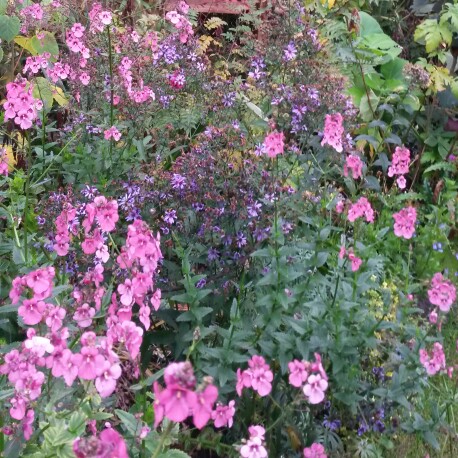
Diascia personata 'Hopleys'
Twinspur 'Hopleys'
Most diascia varieties are low-growing bedding plants, also suitable for containers and hanging-baskets, but some varieties have tall, upright.spires of flowers. The flowers are small, but profuse. The leaves are dark green and oval. 'Hopleys' is a tall variety, with stems bearing an abundance of pink flowers throughoutt the Summer months and into Autumn.
Contributed by @schefflera
-
Full sun to partial shade
-
Occasional watering
-
A little frost hardy: 32F (0°C)
-
Free draining and fertile
Common name
Twinspur 'Hopleys'
Latin name
Diascia personata 'Hopleys'
type
Annual or perennial
family
Scrophulariaceae
ph
6.0 - 7.0 Acid - Neutral
Plant & bloom calendar
-
Best time to plant
-
When the plant will bloom
full grown dimensions
 0.50 M
1.20 M
0.50 M
1.20 M
Diascia personata 'Hopleys'
Most diascia varieties are low-growing bedding plants, also suitable for containers and hanging-baskets, but some varieties have tall, upright.spires of flowers. The flowers are small, but profuse. The leaves are dark green and oval. 'Hopleys' is a tall variety, with stems bearing an abundance of pink flowers throughoutt the Summer months and into Autumn.
Flowering
From Early Spring TO Late Autumn
Diascia have a long flowering season, from early Summer to late Autumn in UK - in their native South Africa the flowering season is shorter
Planting
From Mid Spring TO Late Spring
Plant in Spring in a sunny site in well-drained fertile, good-quality soil.
Propagating by cuttings
From Early Spring TO Mid Spring
Take cuttings from new growth early in the day in Spring. Cut, neatly, a 4" approx. piece of a non-flowering shoot, pinch out the tip, and cut off the bottom leaves. Dip the bottom of the cutting in hormone rooting powder, and carefully place in a pot of cutting compost with the leaves just above the level of the compost. Water, label, cover with a polythene bag, and place in a warm, bright place, out of direct sunlight. Take the polythene bag off periodically for a while for ventilation (at least twice a week)













